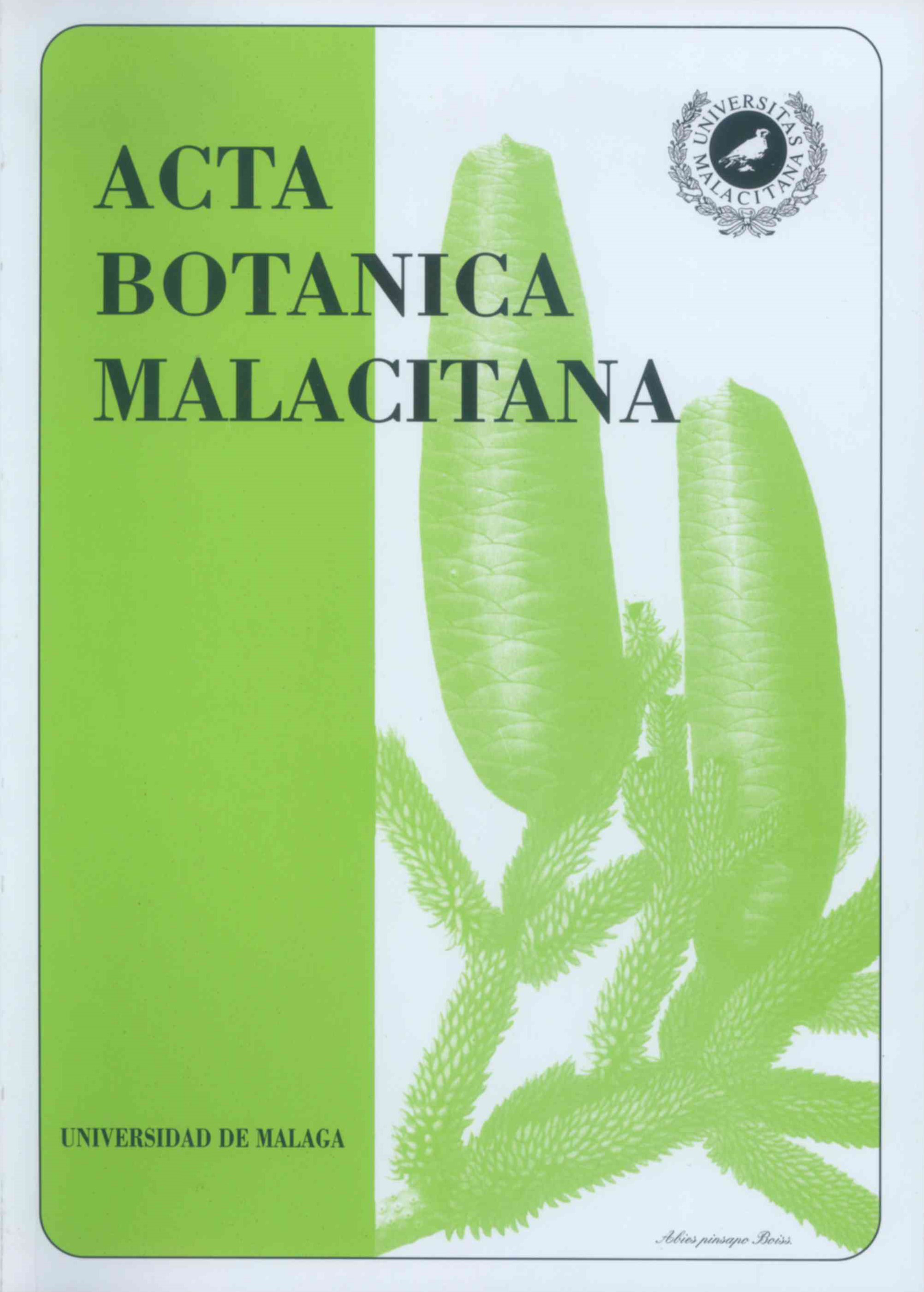Echinospartum algibicum (Leguminosae), plant regeneration via adventitious organogenesis
DOI:
https://doi.org/10.24310/abm.v22i0.8604Keywords:
Conservation, Eehinospartum, seed germination, mycorrhizaAbstract
In vitro seed germination of E. algibicum, an endangered species, multiple bud induction and shoot growth was achieved on a growth medium composed of half strength Murashige and Skoog medium, with 3% sucrose and BAP at 1 and 2 mg (ECH- I , ECH-2). Seed germination increased significantly after scarification (from 38% to almost 100%). The mean number of buds formed after 35-40 days was 8.6 and 6.9 on ECH-1 and ECH-2 media respectively. Shoots were then rooted on the same medium but substituting the cytokinin by the auxin IBA (0.2 mg 1 -1 ). On this medium the mean maximum rooting percentage was 35.49 after 25-30 days; in some cases, callus formation took place on the shoot areas in contact with the nutrient medium. Finally, acclimatization of rooted shoots was achieved through progressive reduction of relative humidity and after several treatments including use of CO2, addition of mycorrhizal fungus (Glomus deserticola) inocula to the substrate, as well as the use of a nutrient medium lacking any plant growth regulators with half the amount of sucrose, prior transferring to soil. After 60 days in soil, survival rates were higher for plants treated with CO2 , although the mean survival percentages were rather low.
Downloads
Metrics
References
APARICIO, A. y R. GUISANDE -1995- Ecología y conservación de Echinospartum algibicum Talavera & Aparicio (Genisteae, Fabaceae). Acta Bot. Malacitana 20: 298-301.
APARICIO A. & R. GUISANDE -1997- Replenishment of the endangered Echinospartum algibicum (Genisteae, Fabaceae) from the soil seed bank. Biological Conservation 79: 267-273.
APARICIO, A. y S. SILVESTRE -1987- Flora del Parque Natural de la Sierra de Grazalema. Agencia de Medio Ambiente, Sevilla.
ARREGUI, J.M., J. JUAREZ, E. LAGUNA, S. REYNA y L. NAVARRO -1993- Micropropagación de Cistus heterophyllus. Un ejemplo de la aplicación del cultivo de tejidos a la conservación de especies amenazadas. Vida Silvestre 74: 24-29.
BRAMWELL, D. -1990- The role of in vitro cultivation in the conservation of endangered species. En: J.E. Hernandez Bermudez, M.Clemente y V. Heywood (eds.), Conference on Conservation Techniques in Botanic Gardens, pp. 3-15, Córdoba, España. Koenigstcin: Koeltz Scientific Books.
CLEMENTE, M., P. CONTRERAS, J. SUSIN & F. PLIEGO ALFARO -1991- Micropropagation of Artemisia granatensis Boiss. Hortscience 26: 420.
CHEE, P.P. -1995- Stimulation of adventitious rooting of Taxus species by thiamine. Plant Cell Rep. 14: 753-757.
FAY, M.F. -1992- Conservation of rare and endangered plants using in vitro methods. J. In Vitro Cell Develop. Biol.- Plant 28: 1-4.
HUSSEY, G. -1986- Vegetative propagation of plant by tissue culture. En: M.M. Yeoman (ed.), Plant Cell Culture Technology, Botanical Monograph vol. 23. pp. 29-66. Blackwell Scientific Publications, Gran Bretaña.
MURASHIGE, T. & F. SKOOG -1962- A revised medium for rapid growth and bio-assays with tobacco tissue cultures. Physiol. Plant. 15: 473- 497.
PENNELL, D. -1987- Micropropagation in Horticulture. Grower Books, Londres.
PHILLIPS, J.M. & D.S. HAYMAN -1970- Improved procedures for clearing roots and staining parasitic and vesicular-arbuscular mycorrhizal fungi for rapid assessment of infection. Transactions of the British Mycological Society 55: 158-161.
RIVAS MARTÍNEZ, S -1974- Echinospartum lusitanicum (L.) Rothm., amplo sensu. Bol. R. Soc. Española Hist. Nat. (Biol.) 72 :13-18.
SCOTT, M.A. -1986- Weaning of Cultured Plants. En: P.G. Alderson y W.M. Dullforce (eds), Micropropagation in Horticulture: Practice and Commercial Problems. Proceedings of the Inst. of Horticulture Symposium, pp. 173-182. Universidad de Nottingham School of Agriculture.
STAFFORD, A. -1991- Genetics of Cultured Plant Cells. En: A. Stafford y G. Warren (eds.), Plant Cell and Tissue Culture, pp. 25-46. Open University Press, Gran Bretaña.
TALAVERA, S y A. APARICIO -1995- Una nueva especie del género Echinospartum (Spach) Rothm. Acta Bot. Malacitana 20: 295-298.
TREMBLAY, F.M., P. PERINET & M. LALINDE - 1986- Tissue culture of Alnus spp. with regard to symbioses. En: Y.P.S. Bajaj (ed.), Biotechnology in Agriculture and Forestry I, pp. 87-100, Springer-Berlag, Berlín, Alemania.
YEOMAN, M.M. -1986- Plant Cell Culture Technology. Botanical Monographs Vol. 23. M.M. Yeoman (ed). Blackwell Scientific, Gran Bretaña.
ZÁRATE, R., M. CANTOS & A. TRONCOSO - 1997- Induction and development of adventitious shoots of Atropa baetica as a means of propagation. Euphytica 94: 361-366.
Downloads
Published
How to Cite
Issue
Section
License
Those authors who publish in this journal accept the following terms:
a. The authors will retain their copyrights and guarantee the journal the right of first publication of their work, which will be simultaneously subject to the Creative Commons Attribution-Non-commercial 4.0 license whose full text can be found at <http: // creative commons .org / licenses / by-nc / 4.0> that allows third parties to share the work as long as its author and its first publication are indicated, and as long as it is not for commercial purposes.
b. Authors may adopt other non-exclusive licensing agreements for the distribution of the version of the published paper (e.g., deposit it in an institutional telematic file or publish it in a monographic volume) provided that the initial publication in this journal be indicated.
c. Authors are allowed and recommended to disseminate their work through the Internet (e.g., in institutional telematic archives or on their websites) before and during the submission process, which can produce interesting exchanges and increase citations of the published work. (See The effect of open access)







1.png)
